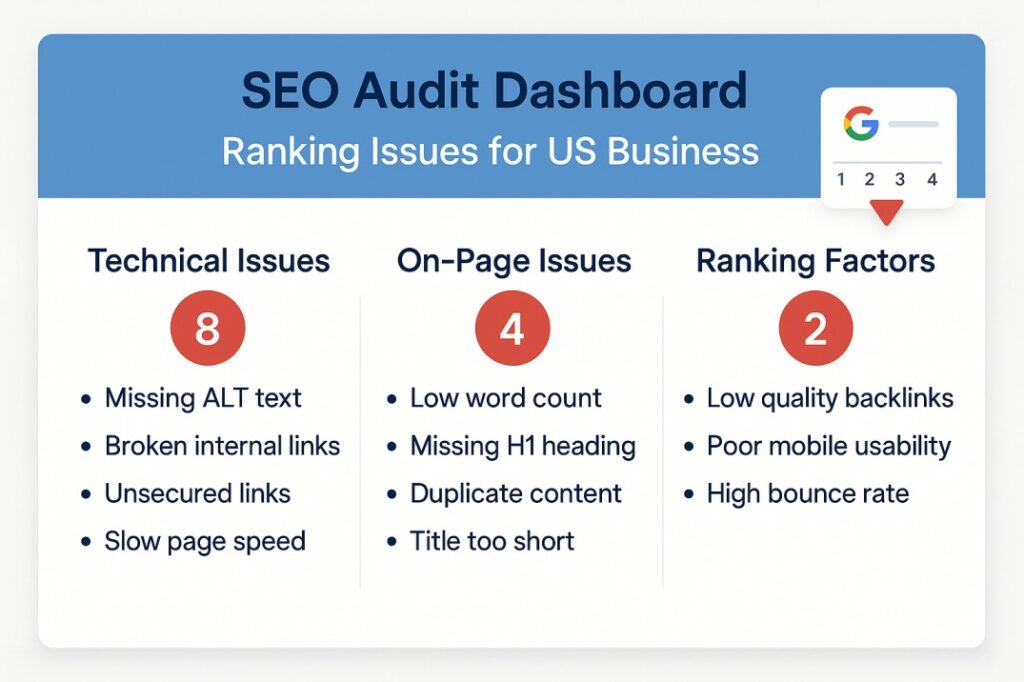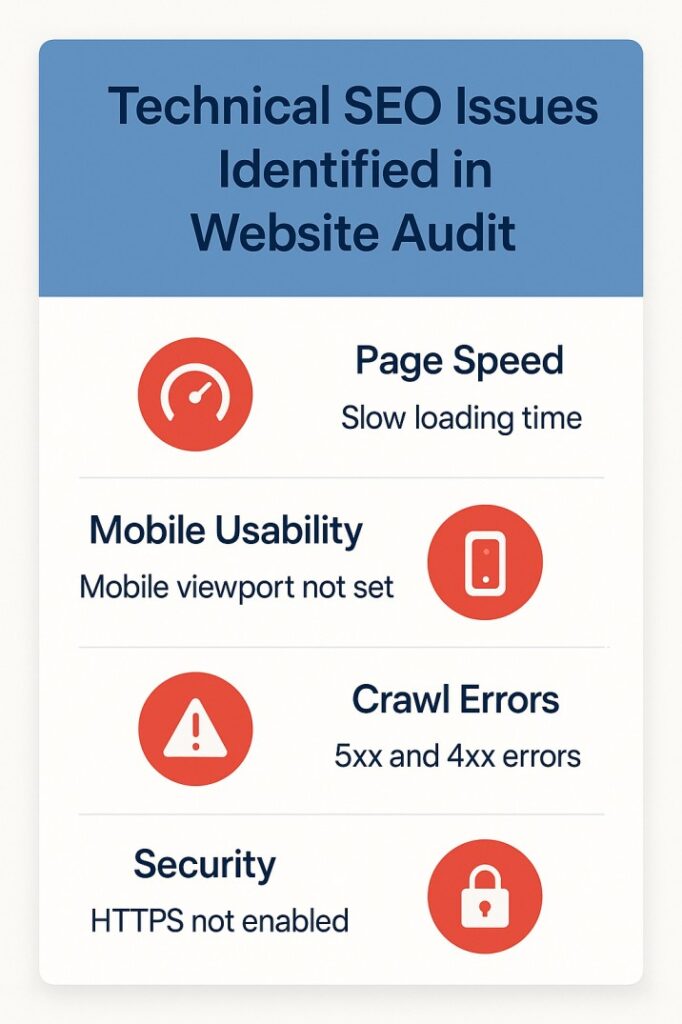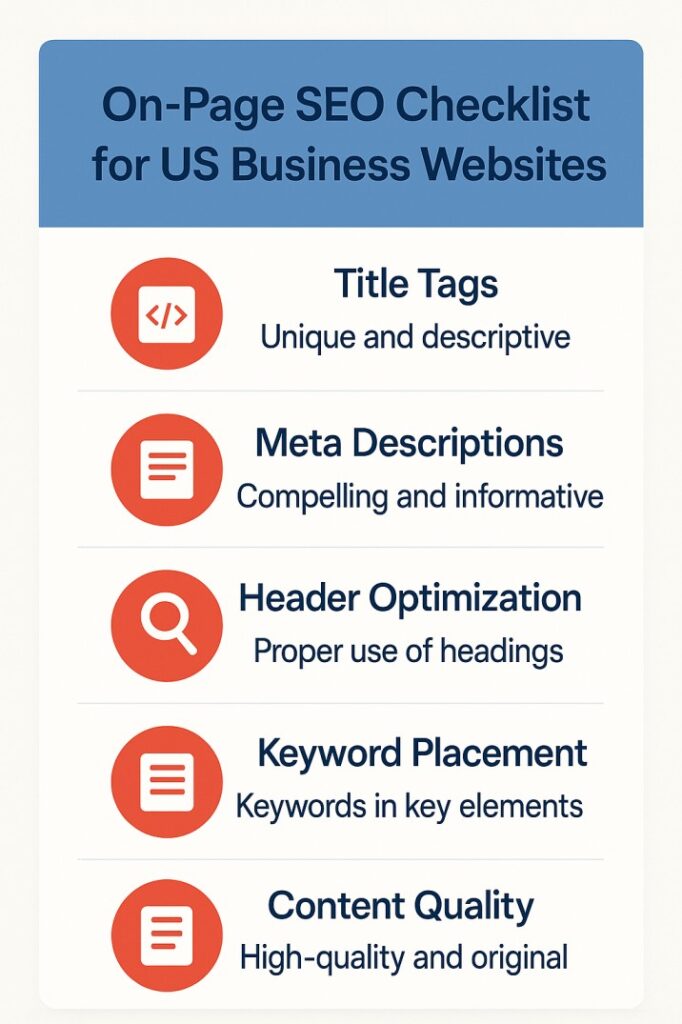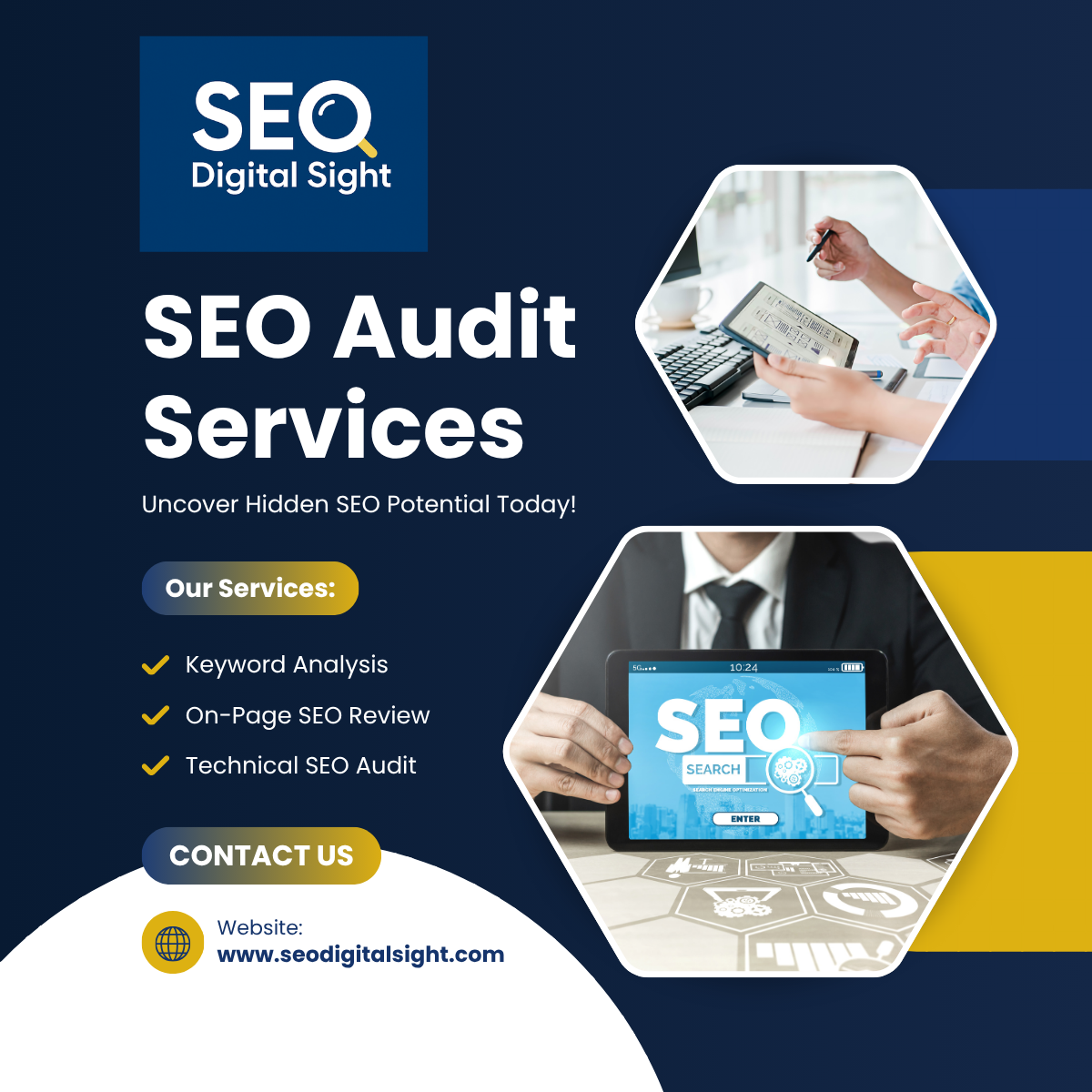You’ve invested in a professional website, published quality content, and targeted the right keywords. Yet your US business still isn’t appearing on Google’s first page. Your competitors seem to dominate search results while you remain invisible to potential customers actively searching for your products or services.
The frustration is real, and the cost is substantial. Every day your website doesn’t rank #1, you’re losing qualified leads, revenue, and market share to competitors who have cracked the code. But here’s the truth: ranking problems rarely stem from a single issue. They’re usually the result of multiple technical SEO issues, on page optimization gaps, and strategic missteps that only a comprehensive SEO audit can reveal.
This guide will walk you through exactly what a professional free SEO audit uncovers, why your website isn’t ranking, and the specific steps US businesses must take to claim that coveted #1 position on Google.

What Is an SEO Audit and Why Does Your US Business Need One?
An SEO audit is a comprehensive analysis of your website’s ability to appear in search engine results. Think of it as a health check for your online presence, examining every factor that influences your website ranking factors from technical infrastructure to content quality to competitive positioning.
For US businesses, regular SEO audits are essential because:
The Digital Landscape Constantly Evolves: Google updates its algorithm over 500 times annually. What worked six months ago may now be hurting your rankings. A thorough SEO audit identifies how recent changes impact your site.
Competition Intensifies Daily: Your competitors aren’t standing still. They’re optimizing, building links, and improving content. Without regular audits, you won’t know where you’re falling behind.
Technical Issues Accumulate: Websites develop problems over time including broken links, slow page speeds, mobile usability issues, and security vulnerabilities. These technical SEO issues silently erode rankings.
Opportunities Get Missed: Audits reveal untapped keyword opportunities, content gaps, and strategic advantages your competitors haven’t yet exploited.
ROI Demands Accountability: Marketing budgets require justification. SEO audits provide data driven insights showing exactly where to invest resources for maximum ranking improvements.
The True Cost of Not Ranking #1
Before diving into audit specifics, understand what’s at stake. Research consistently shows that the #1 position on Google captures approximately 28% of all clicks. Position #2 gets 15%, #3 receives 11%, and it drops dramatically from there. By page two, you’re essentially invisible, capturing less than 1% of search traffic.
For a competitive keyword with 10,000 monthly searches, ranking #1 versus #5 could mean the difference between 2,800 website visits versus 800. If your conversion rate is 3%, that’s 84 customers versus 24, representing 60 lost customers every single month. At an average customer value of $500, you’re leaving $30,000 monthly on the table, totaling $360,000 annually.
Now you understand why improve US website ranking isn’t just about vanity metrics. It’s about revenue, growth, and business survival.

The Complete SEO Audit Checklist 2025: What Gets Examined
A professional SEO audit checklist 2025 examines hundreds of ranking factors across multiple categories. Here’s what comprehensive audits include:
Technical SEO Audit Components
Website Crawlability and Indexation:
- Robots.txt file configuration
- XML sitemap quality and submission
- Canonical tag implementation
- URL structure and hierarchy
- Duplicate content issues
- Redirect chains and loops
- Orphaned pages without internal links
Site Performance Metrics:
- Page load speed (target under 2 seconds)
- Core Web Vitals scores (LCP, FID, CLS)
- Server response time
- Image optimization and compression
- JavaScript and CSS minification
- Browser caching configuration
- Content Delivery Network (CDN) usage
Mobile Optimization:
- Mobile responsive design quality
- Mobile usability issues
- Touch element sizing
- Mobile page speed
- Mobile first indexing compliance
- Accelerated Mobile Pages (AMP) implementation
Security and Accessibility:
- HTTPS/SSL certificate status
- Mixed content warnings
- Security vulnerability scans
- Accessibility compliance (WCAG standards)
- Site architecture and navigation logic
On Page SEO Checklist
Content Quality Analysis:
- Thin or duplicate content identification
- Content depth and comprehensiveness
- Readability and user engagement metrics
- Content freshness and update frequency
- Multimedia integration (images, videos)
- Internal linking structure and anchor text
Keyword Optimization:
- Title tag optimization and keyword placement
- Meta description effectiveness
- Header tag hierarchy (H1, H2, H3)
- Keyword density and natural usage
- Semantic keyword integration
- Long tail keyword targeting
- Keyword cannibalization issues
User Experience Signals:
- Bounce rate analysis
- Average session duration
- Pages per session
- Click through rates from search results
- Conversion funnel performance
- Call to action effectiveness
Schema Markup Implementation:
- Structured data types present
- Schema validation and errors
- Rich snippet eligibility
- Local business markup
- FAQ and How To schema
- Product and review schema
Off Page SEO Factors
Backlink Profile Analysis:
- Total number of referring domains
- Domain authority of linking sites
- Anchor text distribution
- Link velocity and growth patterns
- Toxic or spammy link identification
- Competitor backlink comparison
- Link gap opportunities
Local SEO Audit USA Components:
- Google Business Profile optimization
- NAP (Name, Address, Phone) consistency
- Local citation accuracy across directories
- Review quantity, quality, and velocity
- Local keyword rankings
- Geographic targeting effectiveness
- Local pack visibility
Brand Signals:
- Branded search volume trends
- Social media presence and engagement
- Brand mentions across the web
- Online reputation management
- Trust and authority indicators

Why Is My Website Not Ranking? The 12 Most Common Culprits
Through analyzing thousands of SEO audits for US businesses, certain patterns emerge. Here are the most frequent ranking killers and how to identify them:
1. Glacially Slow Page Speed
If your pages take longer than 3 seconds to load, you’re losing rankings and visitors. Google’s algorithm heavily weights page speed, and users abandon slow sites at alarming rates. 53% of mobile users leave pages that take over 3 seconds to load.
Audit Check: Use Google PageSpeed Insights or GTmetrix to measure load times. Look for scores below 80/100 as red flags requiring immediate attention.
Common Causes: Unoptimized images (the #1 culprit), excessive JavaScript, lack of browser caching, poor hosting infrastructure, too many plugins or third party scripts.
Solution: Compress images using WebP format, implement lazy loading, minify code, upgrade hosting, use a CDN, and eliminate unnecessary plugins.
2. Mobile Unfriendly Design
Over 60% of Google searches happen on mobile devices. If your site doesn’t provide an excellent mobile experience, Google won’t rank you highly regardless of your desktop performance.
Audit Check: Google’s Mobile Friendly Test tool reveals mobile usability issues. Also check your Search Console for mobile usability errors.
Common Causes: Non responsive design, small tap targets, horizontal scrolling required, pop ups covering content, slow mobile load times.
Solution: Implement responsive design, test on actual mobile devices, optimize mobile page speed separately, and ensure touch elements are properly sized.
3. Weak or Missing Title Tags and Meta Descriptions
Your title tags and meta descriptions are your advertisement in search results. Weak ones cost you clicks even when you do rank.
Audit Check: Review title tags for keyword placement, uniqueness, and compelling copy. Check character limits (60 for titles, 160 for descriptions).
Common Issues: Duplicate titles across pages, missing keywords, generic descriptions like “Home Page,” exceeding character limits causing truncation, or no meta descriptions at all.
Solution: Write unique, compelling title tags for every page including primary keywords near the beginning. Craft meta descriptions that encourage clicks while accurately describing content. For professional optimization, consider comprehensive SEO services that include complete on page optimization.
4. Poor Content Quality and Thin Pages
Google rewards comprehensive, valuable content that thoroughly addresses user intent. Thin pages with minimal content rarely rank for competitive terms.
Audit Check: Identify pages with under 300 words (500+ is better for competitive topics). Analyze bounce rates and time on page as quality indicators.
Common Issues: Service pages with only 150 words, blog posts that don’t adequately cover topics, duplicate content across multiple pages, outdated information that’s no longer accurate.
Solution: Expand thin content to at least 1,000 words for important pages, update old content regularly, add unique value and insights, include multimedia elements, and answer common user questions comprehensively.
5. Neglected Technical SEO Issues
Technical problems often go unnoticed because your site appears to function normally. But search engines see these issues clearly, and they significantly impact rankings.
Audit Check: Use tools like Screaming Frog SEO Spider or Sitebulb to crawl your entire site and identify technical issues. Google Search Console also reports many technical problems.
Common Issues: Broken links (404 errors), redirect chains, missing or incorrect canonical tags, improper robots.txt blocking important pages, duplicate content issues, missing XML sitemap, poor URL structure.
Solution: Fix broken links immediately, implement proper canonical tags, optimize robots.txt, create and submit accurate XML sitemaps, and establish clean URL hierarchies. A thorough technical SEO audit identifies and prioritizes fixes.
6. Weak Backlink Profile
Backlinks remain one of Google’s strongest ranking signals. Without quality links from authoritative sites, outranking established competitors becomes nearly impossible.
Audit Check: Use tools like Ahrefs, Moz, or SEMrush to analyze your backlink profile. Compare your referring domains count to competitors ranking above you.
Common Issues: Too few total backlinks, links from low quality or spammy sites, over optimized anchor text, lack of diversity in linking domains, no links from industry authorities.
Solution: Create linkable assets (research, tools, comprehensive guides), pursue digital PR opportunities, guest post on authoritative sites, build relationships with industry influencers, and fix or disavow toxic links.
7. Keyword Targeting Problems
Targeting the wrong keywords, too many keywords, or keywords that don’t match user intent sabotages ranking efforts before they begin.
Audit Check: Analyze whether your target keywords align with actual search volume and commercial intent. Use tools for keyword research for American businesses to identify better opportunities.
Common Issues: Targeting overly broad keywords with impossible competition, focusing on keywords with no commercial intent, keyword stuffing pages unnaturally, neglecting long tail variations, missing local modifiers for location based businesses.
Solution: Conduct fresh keyword research targeting terms your audience actually searches, focus on long tail keywords with commercial intent, optimize different pages for different keyword groups, and incorporate local keywords for geographic targeting.
8. Inadequate Local SEO for US Businesses
If you serve specific geographic areas but haven’t optimized for local search, you’re invisible to nearby customers actively looking for your services.
Audit Check: Search for your business and services with location modifiers. Check if you appear in Google’s local pack (map results). Verify your Google Business Profile completeness.
Common Issues: Unclaimed or unoptimized Google Business Profile, inconsistent NAP across directories, missing local keywords, no local content, few customer reviews, absent location pages.
Solution: Claim and fully optimize your Google Business Profile, build citations on relevant directories, generate customer reviews systematically, create location specific content, and implement local SEO strategies targeting your service areas.
9. Poor User Experience Signals
Google measures how users interact with your site after clicking from search results. Poor user experience signals tell Google your site doesn’t satisfy searchers, causing ranking drops.
Audit Check: Review Google Analytics for high bounce rates (over 70%), low session duration (under 1 minute), and minimal pages per session (under 2).
Common Issues: Confusing navigation, intrusive pop ups, aggressive advertising, misleading titles that don’t match content, difficult to read design, unclear calls to action.
Solution: Simplify navigation, delay pop ups until users engage with content, ensure mobile friendliness, align content with title promises, improve readability with better formatting, and guide users with clear CTAs.
10. Competitor Advantages You Haven’t Identified
Your competitors ranking above you have advantages you may not see without systematic competitor SEO analysis.
Audit Check: Identify your top 5 competitors for important keywords. Analyze their backlink profiles, content strategies, technical implementations, and on page optimization.
Common Issues: Competitors have more authoritative backlinks, publish content more frequently, target better keywords, have stronger domain authority, maintain fresher content, or have superior technical implementation.
Solution: Conduct thorough competitive analysis identifying specific advantages. Create strategies to match or exceed competitor strengths, find weaknesses you can exploit, target keyword gaps they’ve missed, and pursue link opportunities they’ve captured.
11. Missing or Improper Schema Markup
Schema markup helps search engines understand your content context, leading to rich results that increase visibility and click through rates.
Audit Check: Use Google’s Rich Results Test or Schema Markup Validator to check implementation. Review if competitors have rich results you lack.
Common Issues: No schema markup implemented, incorrect schema type for content, validation errors preventing rich results, missing opportunities for FAQ or How To schema.
Solution: Implement appropriate schema types (Article, Local Business, FAQ, Product, Review), validate all markup, monitor Search Console for rich result issues, and test regularly as schema standards evolve.
12. Algorithm Penalty or Manual Action
Sometimes ranking problems stem from Google penalties either algorithmic or manual for violating quality guidelines.
Audit Check: Check Google Search Console for manual action notifications. Review traffic drops coinciding with known algorithm updates.
Common Issues: Unnatural link patterns, thin or duplicate content, cloaking or sneaky redirects, keyword stuffing, user generated spam, purchased links.
Solution: Address the specific violation causing penalties, submit reconsideration requests for manual actions, clean up link profiles, improve content quality, and follow Google’s webmaster guidelines strictly.
How to Conduct Your Own Free SEO Audit: Step by Step
While professional audits provide deeper insights, you can start identifying issues immediately with this process:
Step 1: Analyze Core Performance Metrics (30 Minutes)
Google Search Console: Log into Search Console and review the Performance report. Identify your top performing pages, keywords driving traffic, average position, and click through rates. Look for pages ranking between positions 5 to 15 with good impressions but low clicks (these are optimization opportunities).
Google Analytics: Check your overall organic traffic trends. Are you growing, flat, or declining? Review bounce rates by page, average session duration, and conversion paths. High bounce rates indicate content or user experience problems.
PageSpeed Insights: Test your homepage and 5 most important pages. Aim for scores above 80 on both mobile and desktop. Note specific recommendations Google provides.
Step 2: Technical Foundation Check (45 Minutes)
Mobile Friendly Test: Verify mobile usability using Google’s tool. Address any issues immediately as mobile first indexing makes this critical.
HTTPS Status: Confirm your entire site uses HTTPS. Mixed content warnings hurt rankings and user trust.
XML Sitemap: Locate your XML sitemap (usually at yoursite.com/sitemap.xml) and verify it’s properly formatted and submitted to Search Console.
Robots.txt: Check yoursite.com/robots.txt to ensure you’re not accidentally blocking important pages from crawling.
Crawl Errors: Review Search Console’s Coverage report for crawl errors, pages not indexed, and issues preventing proper indexing.
Step 3: On Page SEO Review (60 Minutes)
Title Tags: Review title tags for your top 20 pages. Ensure each is unique, includes primary keywords near the beginning, and stays under 60 characters.
Meta Descriptions: Check that every important page has a unique, compelling meta description under 160 characters with primary keywords included naturally.
Header Tags: Verify proper H1 usage (one per page with primary keyword) and logical H2 H3 hierarchy.
Content Quality: Assess if your main pages adequately cover topics. Competitive topics often require 1,500+ words with comprehensive information.
Internal Linking: Check if pages link to related content naturally. Strong internal linking helps both users and search engines understand site structure.
Step 4: Backlink Profile Assessment (30 Minutes)
Use free tools like Moz Link Explorer, Ahrefs Backlink Checker (limited free version), or Ubersuggest to analyze your backlink profile.
Questions to Answer:
- How many total referring domains link to your site?
- What’s your domain authority score?
- How does this compare to competitors ranking above you?
- Do you have any obviously spammy or low quality links?
- What are your competitors’ strongest backlinks you lack?
Step 5: Local SEO Verification (If Applicable, 30 Minutes)
Google Business Profile: Claim and completely fill out your profile including business hours, categories, photos, and description.
NAP Consistency: Search for your business name and verify your Name, Address, and Phone number appear identically across all directories.
Reviews: Check your review count and average rating on Google, Yelp, and industry specific platforms. Plan systematic review generation if you have fewer than 20 recent reviews.
Local Keywords: Verify you’re targeting location specific keywords (e.g., “plumber in Austin Texas” not just “plumber”).
Step 6: Competitor Comparison (45 Minutes)
Identify 3 to 5 direct competitors ranking above you for your most important keywords.
Compare:
- Domain authority scores
- Backlink profiles (quantity and quality)
- Content depth and frequency
- Technical implementation
- Social signals and brand presence
Document specific advantages they have and create action plans to match or exceed them.
SEO Tools for Auditing: Free and Premium Options
Free SEO Audit Tools
Google Search Console: Essential free tool providing crawl data, indexing issues, mobile usability problems, and search performance metrics.
Google Analytics: Tracks user behavior, traffic sources, conversion paths, and engagement metrics critical for understanding site performance.
Google PageSpeed Insights: Analyzes page speed on mobile and desktop with specific optimization recommendations.
Google Mobile Friendly Test: Verifies mobile usability and identifies issues preventing good mobile experience.
Screaming Frog SEO Spider (Free up to 500 URLs): Crawls your site identifying technical issues like broken links, duplicate content, and missing meta data.
Ubersuggest: Free version provides keyword research, site audit basics, and limited backlink analysis.
Professional SEO Audit Tools
Ahrefs: Industry leading tool for backlink analysis, competitor research, keyword tracking, and content gap identification.
SEMrush: Comprehensive platform offering site audits, position tracking, competitor analysis, and keyword research.
Moz Pro: Provides domain authority metrics, link analysis, rank tracking, and site crawl reports.
Sitebulb: Desktop crawler offering visual representations of technical issues, making complex problems easier to understand and prioritize.
For US businesses serious about ranking #1, combining free tools with at least one premium platform provides the comprehensive data needed for strategic decision making. Alternatively, partnering with professional SEO services gives you access to enterprise level tools and expert interpretation.
SEO Mistakes to Avoid: What Sabotages Rankings
Beyond specific technical or content issues, certain strategic mistakes keep businesses from achieving #1 rankings:
Chasing Too Many Keywords at Once: Focus creates power. Target 5 to 10 core keywords initially rather than spreading efforts across hundreds.
Neglecting Search Intent: Ranking requires matching search intent. Informational content won’t rank for commercial queries and vice versa.
Forgetting About Updates: Publishing content once then ignoring it guarantees declining rankings. Top content requires regular updates.
Ignoring Mobile Users: With mobile first indexing, desktop optimization alone is insufficient. Mobile experience must be exceptional.
Building Low Quality Links: Quantity never beats quality in link building. One authoritative link outweighs 100 directory submissions.
Copying Competitor Content: Duplicate or similar content won’t outrank the original. Bring unique value and perspectives.
Expecting Overnight Results: SEO requires patience. Meaningful rankings typically take 3 to 6 months of consistent effort.
Not Tracking Results: What gets measured gets improved. Track rankings, traffic, and conversions to guide optimization decisions.
Taking Action: Your Next Steps to Reach #1
You now understand why your US business isn’t ranking #1 and what comprehensive SEO audits reveal. The question becomes: what’s your next move?
Option 1: DIY Audit and Optimization
Use this guide and free tools to conduct your own audit. This works if you have time, willingness to learn, and can implement technical fixes. Budget 10 to 15 hours weekly for meaningful progress.
Best For: Small businesses with limited budgets, simple websites, local service businesses in low competition markets.
Option 2: Professional SEO Audit and Strategy
Get a comprehensive professional audit identifying all issues prioritized by impact. Receive a strategic roadmap for reaching #1 rankings.
Best For: Businesses serious about ranking, competitive markets, websites with technical complexity, companies wanting expert guidance while implementing internally.
Option 3: Full Service SEO Management
Partner with SEO experts who audit, strategize, and implement all optimization work while you focus on running your business.
Best For: Businesses prioritizing growth, competitive industries, companies without in house expertise, organizations wanting predictable results and accountability.
At SEO Digital Sight, we offer all three options tailored to your specific situation. Our free SEO audit provides immediate insights into ranking obstacles and realistic timelines for reaching #1 positions.
Conclusion: Your Path to Google’s #1 Spot Starts with Truth
Ranking #1 on Google isn’t mysterious or impossible. It’s systematic. It requires understanding exactly where you stand today, identifying specific obstacles preventing top rankings, and implementing proven solutions prioritized by impact.
Every day you delay is another day watching competitors capture customers who should be yours. But here’s the encouraging truth: most businesses never take action. They accept mediocre rankings, blame the algorithm, or convince themselves SEO doesn’t work.
You’re different. You’ve invested time understanding what comprehensive SEO audits reveal and why websites don’t rank. You know the common pitfalls and how to avoid them. Now you have a clear path forward.
The question isn’t whether you can rank #1. The question is when will you start?
Ready to discover exactly what’s holding your rankings back? Get your free SEO audit today and receive a personalized analysis of your website’s ranking obstacles, competitive position, and strategic recommendations for reaching that #1 spot your US business deserves.
Don’t let another month pass watching competitors dominate search results. Take control of your rankings today.













